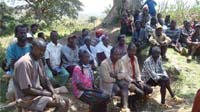18.4 Planning, implementing, monitoring and evaluating advocacy
You need well-planned activities to achieve your advocacy goals and objectives. You also need to identify and attract resources (money, equipment, volunteers, supplies and space) to implement your advocacy campaigns.
The steps discussed in this section will help you when you are planning and implementing advocacy activities.
18.4.1 Identifying the issue
In this step you must think more specifically about what you aim to do. You need to identify the problem that requires a policy action.
18.4.2 Knowing your audience
This means you should decide which audience to target through advocacy, and you must carefully determine the advocacy goals and objectives. At this stage, you are also identifying the policy makers you are trying to influence to support your issue. Examples include politicians, local officials and ministry officials.
18.4.3 Building support
Build alliances with other groups, organisations and individuals who need to become committed to support you in your advocacy work on health issues. You should remember that the campaign will be most effective when individuals and organisations join together in networks in order to increase the strength of your advocacy efforts (Figure 18.5).

18.4.4 Developing your message
An advocacy message is a statement that may be tailored to different audiences. These messages define the issue, state solutions, and describe the actions that need to be taken.
18.4.5 Identifing the channels of communication
Identify the channels and the messages to be delivered to the various target audiences through radio, television, flyers, press conferences, or during meetings.
18.4.6 Resource mobilisation
This means you need to identify and attract resources such as money, equipment, volunteers, supplies and space in order to carry out your advocacy campaign.
18.4.7 Advocacy activity
Once you have mobilised all necessary resources, you will be in a position to implement a set of planned activities, sometimes called an action plan, to achieve your advocacy objectives.
18.4.8 Monitoring and evaluating the activities
You need to monitor the process of an activity and gather information about how it is going, in order to measure progress towards your advocacy goal. Then evaluate the data gathered about the advocacy activities and analyse them to support each step of your advocacy campaign.
In your community or in your work, have you seen an example of someone using advocacy? This may not even be in the area of health. People advocate for education, for children’s rights, for farming resources, and so on. If you have seen advocacy in action, think about it, and look again at the above list and see which stages you can identify.
We don’t know what your example will be, but we hope that you have noticed how many of the features of advocacy are ones which crop up time and again in health education, such as knowing your audience, being clear about the message, checking and monitoring your results, and so on. Underlying all health education issues are these processes that help to clarify what is going on and keep them on track. In the case of advocacy, these processes are applied to solving a problem using a group as a resource.
18.3 Your roles in advocacy
